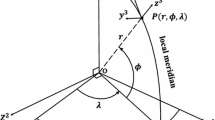Abstract
In [1] expressions were constructed for the derivatives of all the orders of a planet’s gravitational potential with respect to the rectangular coordinates related to the gravity center of a planet. These expressions are series of spherical functions. The coefficients of the series of first-order derivatives depend on two Stokes constants, whereas the coefficients of next-order derivatives are linear combinations of the coefficients of preceding-order derivatives. In the present paper the derived expressions for the first and second potential derivatives are transformed into the form that is most convenient for solving the inverse problem, i.e., evaluating Stokes constants from satellite measurements of these derivatives. Each term of the new series for a derivative depends on a sum of two Stokes constants multiplied by linear combinations of several spherical functions. The new form of the expansions for the potential derivatives makes it possible to calculate Stokes constants by simultaneously applying satellite data either for all three first-order potential derivatives, or for all six second-order derivatives. The constructed series may be applied for modeling the Earth’s gravitational field from the satellite data obtained in the international CHAMP, GRACE, and GOCE missions.
Similar content being viewed by others
References
Petrovskaya, M.S. and Vershkov, A.N., Spherical harmonic series for derivatives of all orders of the gravitational potential of a planet and their application in satellite geodesy and space navigation, Kosm. Issled., 2012, vol. 50, no. 2, pp. 158–165. [Cosmic Research, pp. 152–159].
Reubelt, T., Austen, G., and Grafarend, E.W., Harmonic analysis of the Earth’s gravitational field by means of semi-continuous ephemerides of a low Earth orbiting GPS-tracked satellite. Case study: Champ, J. of Geodesy, 2003, vol. 77, no. 5–6, pp. 257–278.
Reubelt, T., Gotzelmann, M., and Grafarend, E.W., Harmonic analysis of the Earth’s gravitational field from kinematic CHAMP orbits based on the numerically derived satellite accelerations, in Observation of the Earth System from Space, Flury, J., Ed., Berlin, Heidelberg: Springer, 2006. doi:10.100713/3-540-29522-4.
Liu, X., Global gravity field recovery from satellite-to-satellite tracking data with the acceleration approach, Netherlands Geodetic Commission. Publications on Geodesy, no. 68, Delft, Netherlands, 2008.
Xu, P., Position and velocity perturbations for the determination of geopotential from space geodetic measurements, Celestial Mechanics and Dynamical Astronomy, 2000, vol. 100, pp. 231–249.
Bruinsma, S., Migliaccio, F., Forste, C., et al., First GOCE gravity field models derived by three different approaches, J. of Geodesy, 2011, vol. 85, pp. 819–843.
Makarenko, N.L. and Dem’yanov, G.V., Modern status of the problem of studying the Earth’s gravitational field, Tret’ya Vserossiiskaya konferentsiya “Fundamental’noe i prikladnoe koordinatno-vremennoe i navigatsionnoe obespechenie (KVNO-2009)”. 6–9 aprelya 2009 g. (Third All-Russia Conf. “Fundamental and Applied Aspects of Coordinate-Time and Navigation Support” April 6–9, 2009), St. Petersburg, 2009, pp. 33–37.
Koop, R., Global gravity field modeling using satellite gravity gradiometry, Netherlands Geodetic Commission. Publications on Geodesy. New series, Delft, Netherlands, 1993, no. 38.
Rummel, R., Sanso, F., van Gelderen, M., et al., Spherical harmonic analysis of satellite gradiometry, Netherlands Geodetic Commission. Publications on Geodesy. New Series, Delft, Netherlands, 1993, no. 39.
Belikov, M.V., Fully numerical experiment on revealing the efficiency of gradiometry, Preprint of Inst. of Theor. Astronomy, Russ. Acad. Sci., St. Petersburg, 1996, no. 52.
Belikov, M.V., Prompt analysis and synthesis of satellite observations when modeling the Earth’s gravitational field, Preprint of Inst. of Theor. Astronomy, Russ. Acad. Sci., St. Petersburg, 1996, no. 53.
Petrovskaya, M.S., Optimal approach to the investigation of the Earth’s gravitational field by means of satellite gradiomåtry, Artificial Satellites, Warszava, 1996, vol. 31, no. 1, pp. 1–23.
Petrovskaya, M.S., Method of applying satellite gradiometry for investigation of the Earth’s gravitational field, Kosm. Issled., 1999, vol. 37, no. 5, pp. 488–497. [Cosmic Research, pp. 460–469].
Petrovskaya, M.S. and Vershkov, A.N., Non-singular expressions for the gravity gradients in the local northoriented and orbital reference frames, J. of Geodesy, 2006, vol. 80, no. 3, pp. 117–127.
Petrovskaya, M.C. and Vershkov, A.N., Local orbital derivatives of the Earth potential expressed in terms of the satellite Cartesian coordinates and velocity, Artificial Satellites, Warszava, 2007, vol. 42, no. 1, pp. 17–39.
Pavlis, N.K., Holmes, S.A., Kenyon, S.C., and Factor, J.K., An Earth gravitational model to degree 2160: EGM2008 (2008), General Assembly of the European Geosciences Union, Vienna, Austria, April 13–18, 2008.
Rummel, R., Yi, W., and Stummer, C., GOCE gravitational gradiometry, J. of Geodesy, 2011, vol. 85, pp. 777–790.
Author information
Authors and Affiliations
Corresponding author
Additional information
Original Russian Text © M.S. Petrovskaya, A.N. Vershkov, 2014, published in Kosmicheskie Issledovaniya, 2014, Vol. 52, No. 2, pp. 176–184.
Rights and permissions
About this article
Cite this article
Petrovskaya, M.S., Vershkov, A.N. The construction of gravitational field models on the basis of satellite measurements of gravitational potential derivatives. Cosmic Res 52, 166–174 (2014). https://doi.org/10.1134/S0010952514020051
Received:
Published:
Issue Date:
DOI: https://doi.org/10.1134/S0010952514020051




